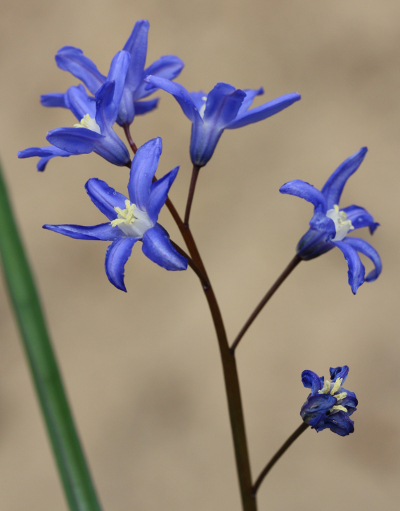Lesser glory-of-the-snow |


Inflorescence and flower of the lesser glory-of-the-snow
| Scilla sardensis Whittall ex Barr & Sayden: | |
| Blooming period: | February–March |
| Height: | 5–10 cm |
| Flowers: | bisexual, actinomorphic, blue, conspicuous, Ø approx. 25 mm, stamens: 6, styles: 1 |
| Tepals:: | 6, blue |
| Leaves: | 2–3, basal, parallel-veined |
Plant perennial, herbaceous with up to 2 cm thick bulb.
Stems upright to curved, incl.flower scape about 10 cm high.
Leaves 2, basal, about 15 mm wide, up to about 13 cm long, with a hooded tip which is reddish along the margins.
The stalk bears a terminal, up to 6.5 cm long, reddish brown flower scape bearing 4–22 erect or slightly nodding, sometimes unilateral flowers. Pedicels up to 4 cm long, at the base with a very short and narrow bract.
The 25 mm wide flowers are bell-shaped and pure blue. Sometimes, however, there is a narrow white ring in the center of the flower.
The 6 tepals are fused at the base to 30%–40% of its length.
At the top of the corolla tube arise 6 incurvate stamens with yellow anthers, whose white filaments are widened and cover the ovary.
After insect pollination (bees, bumblebees, wasps) are formed from the superior ovary 3-piece, many-seeded, rounded capsule fruits.
The seeds have a nutrient-rich appendage (elaiosome) and are spread by ants. Propagation also by formation of daughter bulbs. Plants poisonous, especially the bulbs!
| Floral formula: |
| * [P(3+3) A3+3] G(3) superior |
Occurrence:
Roadsides,
parks, public gardens, often near human settlements. Prefers moist,
nutrient-rich, sandy soils and sunny to semi-shady locations.
Distribution:
Originally
western Turkey. In Middle Europe garden escapes.